Novel Cuckoo Search-Based Metaheuristic Approach for Deep Learning Prediction of Depression
Abstract
1. Introduction
1.1. Motivation
1.2. Objective of the Paper
- The goal of this research is to create a model that can recognize suicidal thought patterns in human beings based on their online posts.
- This study’s objective is to provide a deep learning approach for diagnosing depression that can effectively use a constrained collection of features.
- By contrasting the proposed model with other models and taking into account various performance metrics used by various classifiers, its efficacy is evaluated.
- The goal is to run the model independently, without using the user interface.
1.3. Proposed Novel Work
1.4. Paper Organization
2. Literature Review
3. Methods Used
3.1. Deep Learning
3.2. Particle Swarm Optimization (PSO)
3.3. Cuckoo Search (CS)
3.4. Proposed Method
| Algorithm 1: PS-CS Optimization |
|
3.5. PS-CS Update Equation
4. Experimental Setup
4.1. Dataset
4.2. Preprocessing of Dataset
4.2.1. Tokenization
4.2.2. Data Cleaning
4.2.3. Stemming
4.2.4. Embedding Normalization
4.3. Proposed Deep Learning Architecture
4.4. Parameter Setting of Proposed Models
5. Experimental Result and Discussion
5.1. Part A: Comparison of Proposed Approach Performance with Various CNN Based Deep Learning Models
5.1.1. Training and Validation Loss
5.1.2. Precision and Recall
5.1.3. Receiver Operating Characteristic (ROC) Curve
5.2. Part B: Comparison of Proposed Approach Performance with Classification Results of Other Popular Classification Models for Classification of Depressed vs Non-Depressed Patient
5.2.1. R-Squared and Mean Squared Error
5.2.2. Confusion Matrix of Various Classification Models
5.2.3. ROC of Various Classification Models
5.2.4. Comparison of Proposed Model with Other Published Model of Depression Detection
6. Conclusions
Future Work
Author Contributions
Funding
Institutional Review Board Statement
Informed Consent Statement
Data Availability Statement
Conflicts of Interest
References
- He, L.; Guo, C.; Tiwari, P.; Su, R.; Pandey, H.M.; Dang, W. DepNet: An automated industrial intelligent system using deep learning for video-based depression analysis. Int. J. Intell. Syst. 2021, 37, 3815–3835. [Google Scholar]
- Chris, X.; Sanketh, R.P.; Samuel, O. The Depression Dataset (1). Kaggle. 2021. Available online: https://www.kaggle.com/datasets/arashnic/the-depression-dataset (accessed on 24 April 2023).
- Zulfiker, M.S.; Kabir, N.; Biswas, A.A.; Nazneen, T.; Uddin, M.S. An in-depth analysis of machine learning approaches to predict depression. Curr. Res. Behav. Sci. 2021, 2, 100044. [Google Scholar] [CrossRef]
- Dinga, R.; Marquand, A.F.; Veltman, D.J.; Beekman, A.T.; Schoevers, R.A.; Van Hemert, A.M.; Penninx, B.W.; Schmaal, L. Predicting the naturalistic course of depression from a wide range of clinical, psychological, and biological data: A machine learning approach. Transl. Psychiatry 2018, 8, 1–11. [Google Scholar] [CrossRef] [PubMed]
- Khan, A.; Sohail, A.; Zahoora, U.; Qureshi, A.S. A survey of the recent architectures of deep convolutional neural networks. Artif. Intell. Rev. 2020, 53, 5455–5516. [Google Scholar] [CrossRef]
- Nemesure, M.D.; Heinz, M.V.; Huang, R.; Jacobson, N.C. Predictive modeling of depression and anxiety using electronic health records and a novel machine learning approach with artificial intelligence. Sci. Rep. 2021, 11, 1980. [Google Scholar] [CrossRef]
- Imran, A.S.; Daudpota, S.M.; Kastrati, Z.; Batra, R. Cross-cultural polarity and emotion detection using sentiment analysis and deep learning on COVID-19 related tweets. IEEE Access 2020, 8, 181074–181090. [Google Scholar] [CrossRef] [PubMed]
- Hassan, A.U.; Hussain, J.; Hussain, M.; Sadiq, M.; Lee, S. Sentiment analysis of social networking sites (SNS) data using machine learning approach for the measurement of depression. In Proceedings of the 2017 International Conference on Information and Communication Technology Convergence (ICTC), Jeju Island, Republic of Korea, 18–20 October 2017; pp. 138–140. [Google Scholar]
- Li, X.; Zhang, X.; Zhu, J.; Mao, W.; Sun, S.; Wang, Z.; Xia, C.; Hu, B. Depression recognition using machine learning methods with different feature generation strategies. Artif. Intell. Med. 2019, 99, 101696. [Google Scholar] [CrossRef]
- Richter, T.; Fishbain, B.; Markus, A.; Richter-Levin, G.; Okon-Singer, H. Using machine learning-based analysis for behavioral differentiation between anxiety and depression. Sci. Rep. 2020, 10, 16381. [Google Scholar] [CrossRef]
- Priya, A.; Garg, S.; Tigga, N.P. Predicting anxiety, depression and stress in modern life using machine learning algorithms. Procedia Comput. Sci. 2020, 167, 1258–1267. [Google Scholar] [CrossRef]
- Kumar, P.; Garg, S.; Garg, A. Assessment of anxiety, depression and stress using machine learning models. Procedia Comput. Sci. 2020, 171, 1989–1998. [Google Scholar] [CrossRef]
- Choudhury, A.A.; Khan, M.R.H.; Nahim, N.Z.; Tulon, S.R. Predicting Depression in Bangladeshi Undergraduates using Machine Learning. In Proceedings of the 2019 IEEE Region 10 Symposium (TENSYMP), Kolkata, India, 7–9 June 2019; pp. 789–794. [Google Scholar] [CrossRef]
- Shin, D.; Cho, W.I.; Park, C.H.K.; Rhee, S.J.; Kim, M.J.; Lee, H.; Kim, N.S.; Ahn, Y.M. Detection of minor and major depression through voice as a biomarker using machine learning. J. Clin. Med. 2021, 10, 3046. [Google Scholar] [CrossRef] [PubMed]
- Hosseinifard, B.; Moradi, M.H.; Rostami, R. Classifying depression patients and normal subjects using machine learning techniques and nonlinear features from EEG signal. Comput. Methods Programs Biomed. 2013, 109, 339–345. [Google Scholar] [CrossRef] [PubMed]
- Jiménez-Serrano, S.; Tortajada, S.; García-Gómez, J.M. A mobile health application to predict postpartum depression based on machine learning. Telemed. e-Health 2015, 21, 567–574. [Google Scholar] [CrossRef] [PubMed]
- Khalil, R.M.; Al-Jumaily, A. Machine learning based prediction of depression among type 2 diabetic patients. In Proceedings of the 2017 12th International Conference on Intelligent Systems and Knowledge Engineering (ISKE), Nanjing, China, 24–26 November 2017; pp. 1–5. [Google Scholar]
- Zhou, L.; Baughman, A.W.; Lei, V.J.; Lai, K.H.; Navathe, A.S.; Chang, F.; Sordo, M.; Topaz, M.; Zhong, F.; Murrali, M.; et al. Identifying patients with depression using free-text clinical documents. Stud. Health Technol. Inform. 2015, 216, 629–633. [Google Scholar] [PubMed]
- Acharya, U.R.; Oh, S.L.; Hagiwara, Y.; Tan, J.H.; Adeli, H.; Subha, D.P. Automated EEG-based screening of depression using deep convolutional neural network. Comput. Methods Programs Biomed. 2018, 161, 103–113. [Google Scholar] [CrossRef]
- Delgadillo, J.; Gonzalez, S.D.P. Targeted prescription of cognitive–behavioral therapy versus person-centered counseling for depression using a machine learning approach. J. Consult. Clin. Psychol. 2020, 88, 14. [Google Scholar] [CrossRef]
- Ahmad, S.; Asghar, M.Z.; Alotaibi, F.M.; Awan, I. Detection and classification of social media based extremist affiliations using sentiment analysis techniques. Hum. Cent. Comput. Inf. Sci. 2019, 9, 24. [Google Scholar] [CrossRef]
- Rosa, R.L.; Schwartz, G.M.; Ruggiero, W.V.; Rodr, D.Z.-G. A knowledge-based recommen- dation system that includes sentiment analysis and deep learning. IEEE Trans. Ind. Inform. 2019, 15, 2124–2135. [Google Scholar] [CrossRef]
- Cheng, L.C.; Tsai, S.L. Deep learning for automated sentiment analysis of social media. In Proceedings of the 2019 IEEE/ACM International Conference on Advances in Social Networks Analysis and Mining, Vancouver, BC, Canada, 27–30 August 2019. [Google Scholar]
- Tian, J.; Hou, M.; Bian, H.; Li, J. Variable surrogate model-based particle swarm optimization for high-dimensional expensive problems. Complex Intell. Syst. 2022, 29, 1–49. [Google Scholar] [CrossRef]
- Zhang, X.; Huang, D.; Li, H.; Zhang, Y.; Xia, Y.; Liu, J. Self-training maximum classifier discrepancy for EEG emotion recognition. CAAI Trans. Intell. Technol. 2023, 1–12. [Google Scholar] [CrossRef]
- Li, X.; Sun, Y. Application of RBF neural network optimal segmentation algorithm in credit rating. Neural Comput. Appl. 2020, 33, 8227–8235. [Google Scholar] [CrossRef]
- Wang, F.; Wang, H.; Zhou, X.; Fu, R. A Driving Fatigue Feature Detection Method Based on Multifractal Theory. IEEE Sens. J. 2022, 22, 19046–19059. [Google Scholar] [CrossRef]
- Lu, S.; Yang, B.; Xiao, Y.; Liu, S.; Liu, M.; Yin, L.; Zheng, W. Iterative reconstruction of low-dose CT based on differential sparse. Biomed. Signal Process. Control. 2023, 79, 104204. [Google Scholar] [CrossRef]
- Ban, Y.; Wang, Y.; Liu, S.; Yang, B.; Liu, M.; Yin, L.; Zheng, W. 2D/3D Multimode Medical Image Alignment Based on Spatial Histograms. Appl. Sci. 2022, 12, 8261. [Google Scholar] [CrossRef]
- Lv, Z.; Yu, Z.; Xie, S.; Alamri, A. Deep Learning-based Smart Predictive Evaluation for Interactive Multimedia-enabled Smart Healthcare. ACM Trans. Multimed. Comput. Commun. Appl. 2022, 18, 43. [Google Scholar] [CrossRef]
- Cao, H. Entrepreneurship education-infiltrated computer-aided instruction system for college Music Majors using convolutional neural network. Front. Psychol. 2022, 13, 900195. [Google Scholar] [CrossRef] [PubMed]
- Zhou, W.; Lv, Y.; Lei, J.; Yu, L. Global and Local-Contrast Guides Content-Aware Fusion for RGB-D Saliency Prediction. IEEE Trans. Syst. Man, Cybern. Syst. 2019, 51, 3641–3649. [Google Scholar] [CrossRef]
- Huang, C.-Q.; Jiang, F.; Huang, Q.-H.; Wang, X.-Z.; Han, Z.-M.; Huang, W.-Y. Dual-Graph Attention Convolution Network for 3-D Point Cloud Classification. IEEE Trans. Neural Networks Learn. Syst. 2022, 1–13. [Google Scholar] [CrossRef] [PubMed]
- Ren, Y.; Jiang, H.; Ji, N.; Yu, H. TBSM: A traffic burst-sensitive model for short-term prediction under special events. Knowledge-Based Syst. 2022, 240, 108120. [Google Scholar] [CrossRef]
- Zhang, Y.; Huang, Y.; Zhang, Z.; Postolache, O.; Mi, C. A vision-based container position measuring system for ARMG. Meas. Control. 2022, 56, 596–605. [Google Scholar] [CrossRef]
- Mi, C.; Huang, S.; Zhang, Y.; Zhang, Z.; Postolache, O. Design and Implementation of 3-D Measurement Method for Container Handling Target. J. Mar. Sci. Eng. 2022, 10, 1961. [Google Scholar] [CrossRef]
- Aziz, R.M. Application of nature inspired soft computing techniques for gene selection: A novel frame work for classification of cancer. Soft Comput. 2022, 26, 12179–12196. [Google Scholar] [CrossRef]
- Aziz, R.M. Nature-inspired metaheuristics model for gene selection and classification of biomedical microarray data. Med Biol Eng Comput 2022, 60, 1627–1646. [Google Scholar] [CrossRef] [PubMed]
- Aziz, R.; Verma, C.K.; Jha, M.; Srivastava, N. Artificial neural network classification of microarray data using new hybrid gene selection method. International Int. J. Data Min. 2017, 17, 42–65. [Google Scholar] [CrossRef]
- Aziz, R.; Verma, C.K.; Srivastava, N. A novel approach for dimension reduction of microarray. Comput. Biol. Chem. 2017, 71, 161–169. [Google Scholar] [CrossRef] [PubMed]
- Abualigah, L.; Elaziz, M.A.; Khodadadi, N.; Forestiero, A.; Jia, H.; Gandomi, A.H. Aquila Optimizer Based PSO Swarm Intelligence for IoT Task Scheduling Application in Cloud Computing. In Integrating Meta-Heuristics and Machine Learning for Real-World Optimization Problems. Studies in Computational Intelligence; Houssein, E.H., Abd Elaziz, M., Oliva, D., Abualigah, L., Eds.; Springer: Cham, Switzerland, 2022; Volume 1038. [Google Scholar] [CrossRef]
- Forestiero, A. Heuristic recommendation technique in Internet of Things featuring swarm intelligence approach. Expert Syst. Appl. 2021, 187, 115904. [Google Scholar] [CrossRef]
- Yaqoob, A.; Aziz, R.M.; Verma, N.K.; Lalwani, P.; Makrariya, A.; Kumar, P. A review on nature-inspired algorithms for cancer disease prediction and classification. Mathematics 2023, 11, 1081. [Google Scholar] [CrossRef]
- Aziz, R.M.; Mahto, R.; Goel, K.; Das, A.; Kumar, P.; Saxena, A. Modified genetic algorithm with deep learning for fraud transactions of ethereum smart contract. Appl. Sci. 2023, 13, 697. [Google Scholar] [CrossRef]
- Desai, N.P.; Baluch, M.F.; Makrariya, A.; Musheer, A.R. Image processing model with deep learning approach for fish species classification. Turk. J. Comput. Math. Educ. 2022, 13, 85–99. [Google Scholar]
- Aziz, R.M.; Hussain, A.; Sharma, P.; Kumar, P. Machine learning-based soft computing regression analysis approach for crime data prediction. Karbala Int. J. Mod. Sci. 2022, 8, 1–9. [Google Scholar] [CrossRef]
- Aziz, R.M.; Baluch, M.F.; Patel, S.; Kumar, P. A machine learning based approach to detect the Ethereum fraud transactions with limited attributes. Karbala Int. J. Mod. Sci. 2022, 8, 139–151. [Google Scholar] [CrossRef]
- Aziz, R.M.; Sharma, P.; Hussain, A. Machine learning algorithms for crime prediction under Indian Penal Code. Ann. Data Sci. 2022, 6, 1–32. [Google Scholar] [CrossRef]
- He, L.; Niu, M.; Tiwari, P.; Marttinen, P.; Su, R.; Jiang, J.; Guo, C.; Wang, H.; Ding, S.; Wang, Z.; et al. Deep learning for depression recognition with audiovisual cues: A review. Inf. Fusion 2022, 80, 56–86. [Google Scholar] [CrossRef]
- Kameyama, K. Particle swarm optimization—A survey. IEICE Trans. Inf. Syst. 2009, 92, 1354–1361. [Google Scholar] [CrossRef]
- Wu, C.S.; Kuo, C.J.; Su, C.H.; Wang, S.H.; Dai, H.J. Using text mining to extract depressive symptoms and to validate the diagnosis of major depressive disorder from electronic health records. J. Affect. Disord. 2020, 260, 617–623. [Google Scholar] [CrossRef]
- Peña, E.; Zhang, S.; Deyo, S.; Xiao, Y.; Johnson, M.D. Particle swarm optimization for programming deep brain stimulation arrays. J. Neural Eng. 2017, 14, 016014. [Google Scholar] [CrossRef]
- Aziz, R.M. Cuckoo search-based optimization for cancer classification: A new hybrid approach. J. Comput. Biol. 2022, 29, 565–584. [Google Scholar] [CrossRef]
- Aziz, R.M.; Desai, N.P.; Baluch, M.F. Computer vision model with novel cuckoo search based deep learning approach for classification of fish image. Multimed. Tools Appl. 2022, 14, 1–20. [Google Scholar] [CrossRef]
- Katchapakirin, K.; Wongpatikaseree, K.; Yomaboot, P.; Kaewpitakkun, Y. Facebook social media for depression detection in the thai community. In Proceedings of the 2018 15th International Joint Conference on Computer Science and Software Engineering (JCSSE), Nakhon Pathom, Thailand, 11–13 July 2018; pp. 1–6. [Google Scholar]
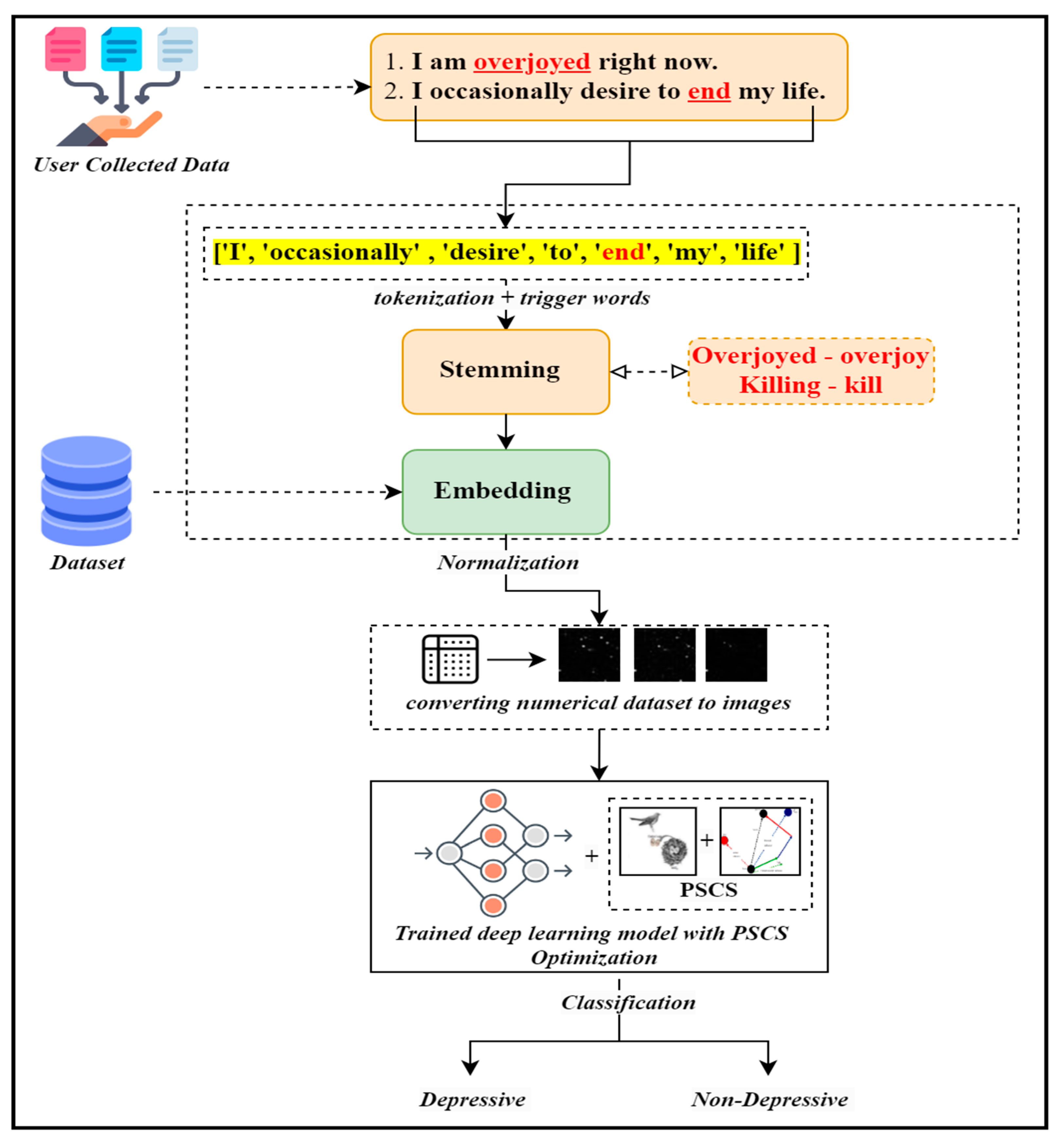
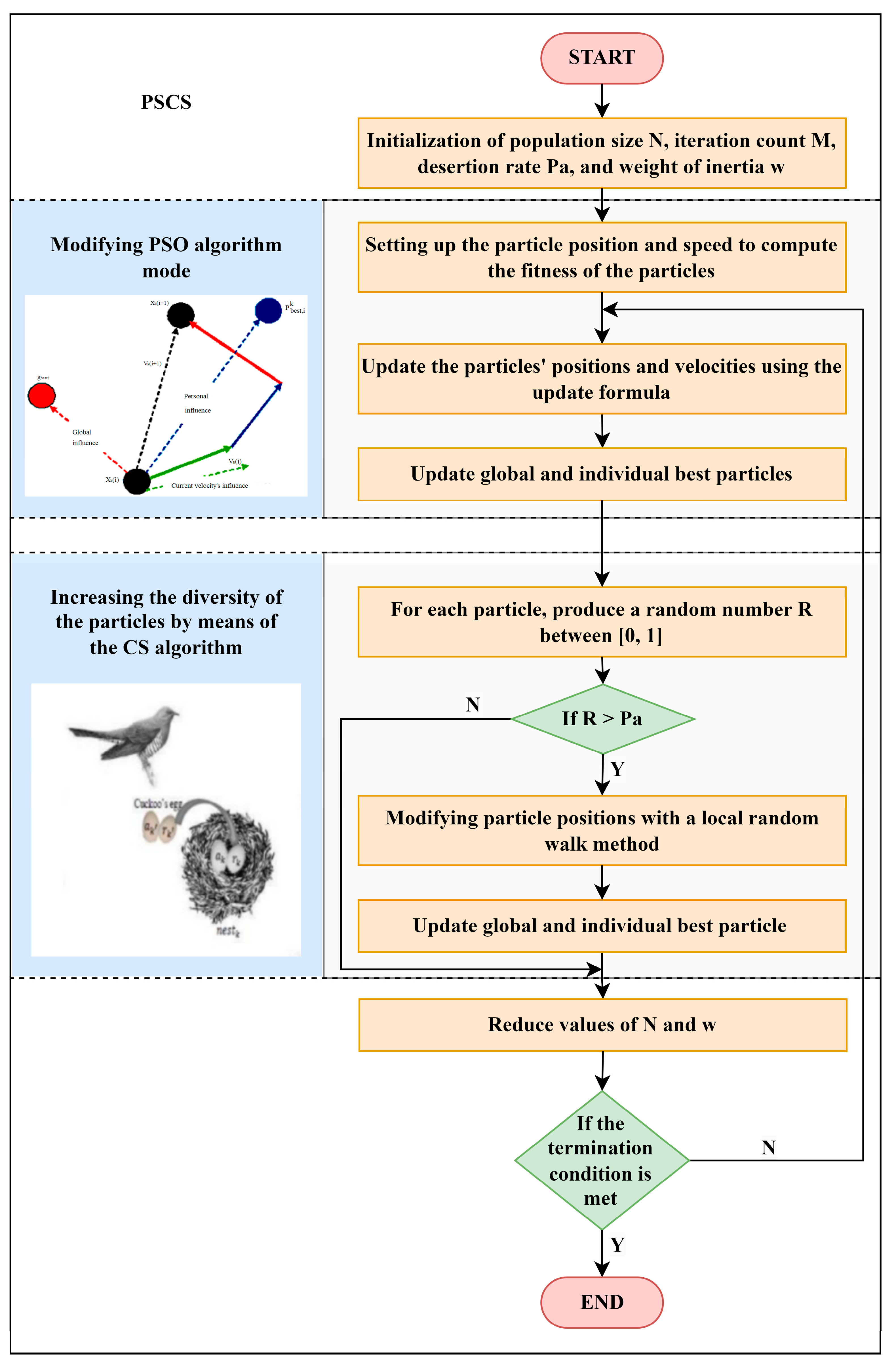


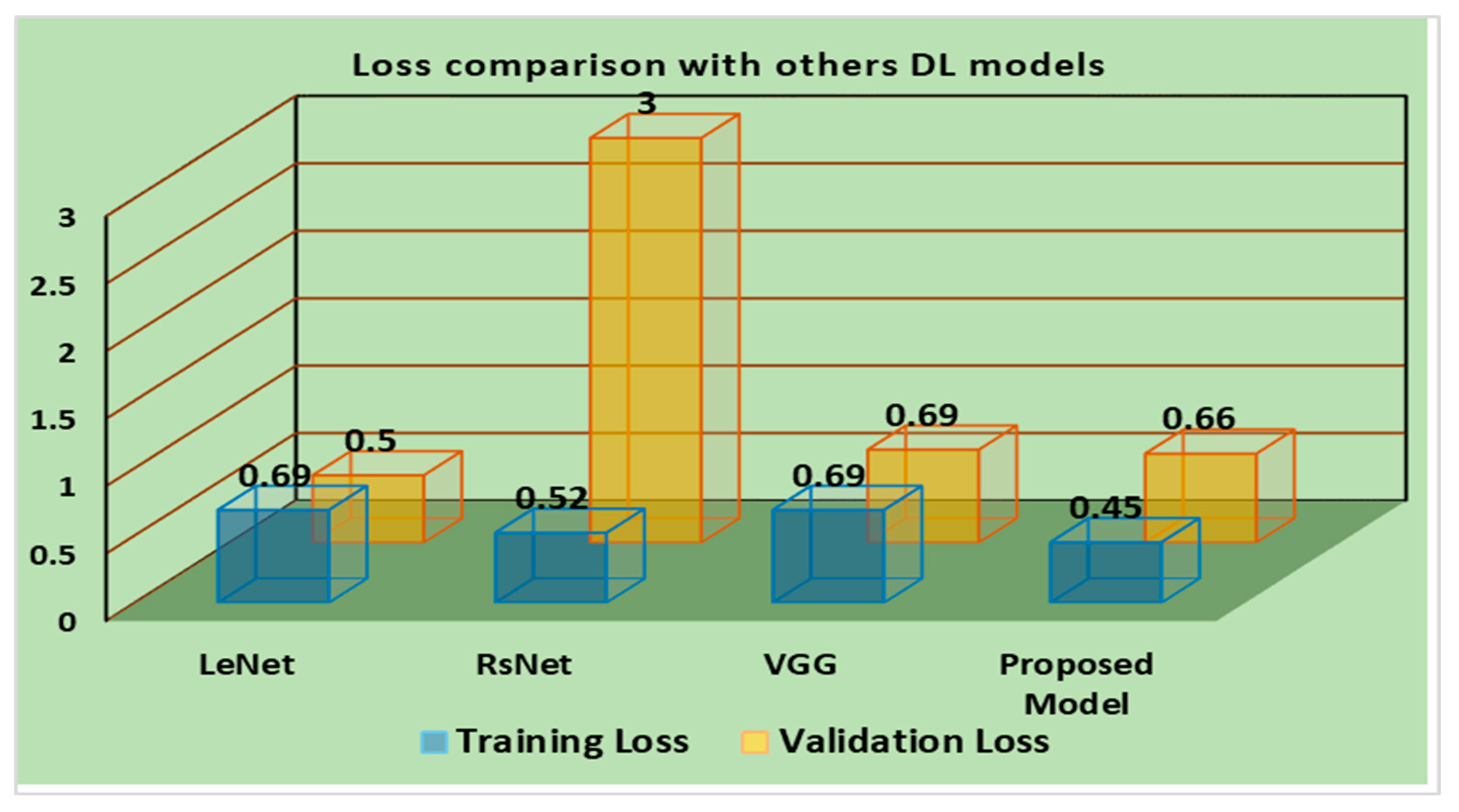

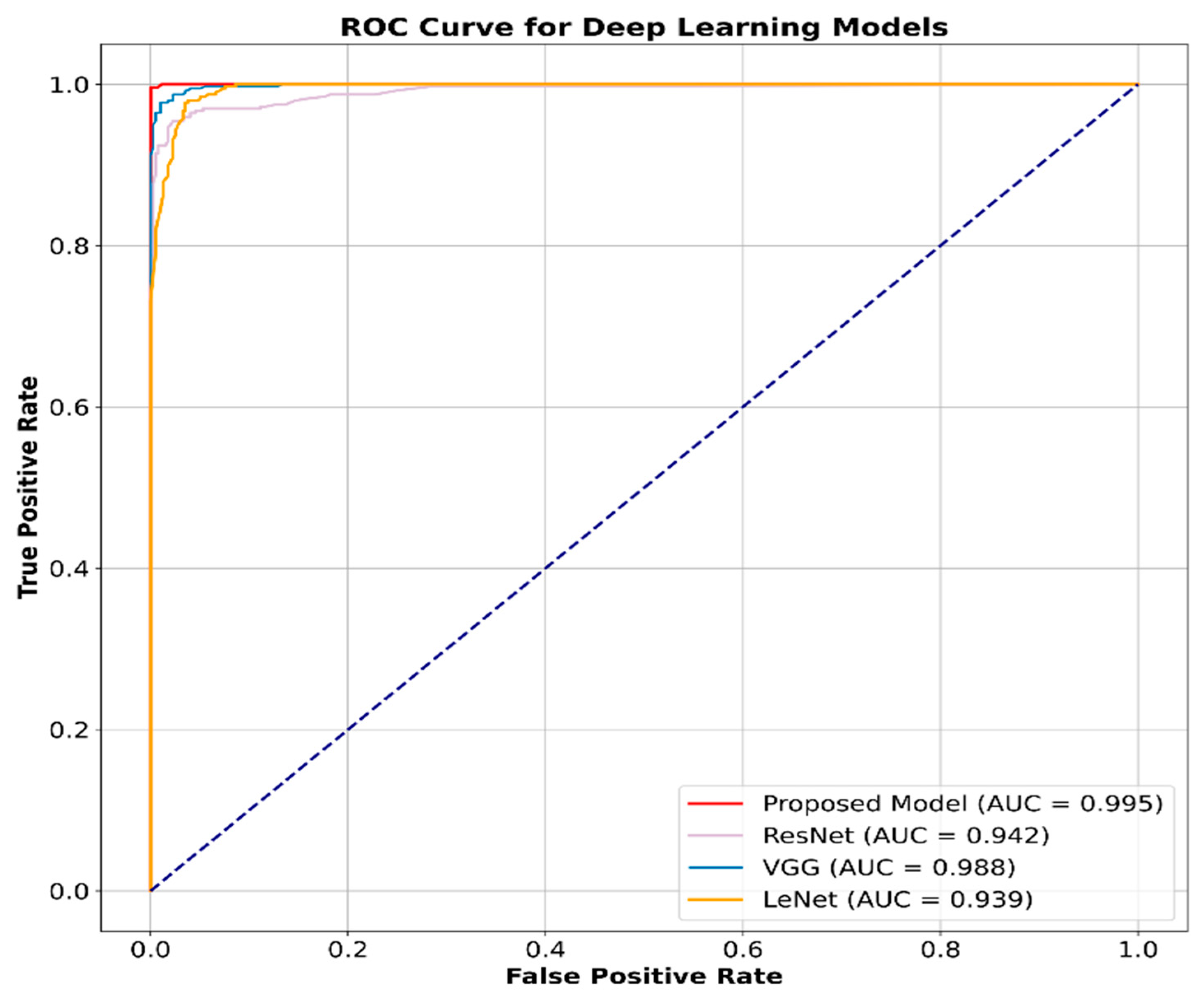
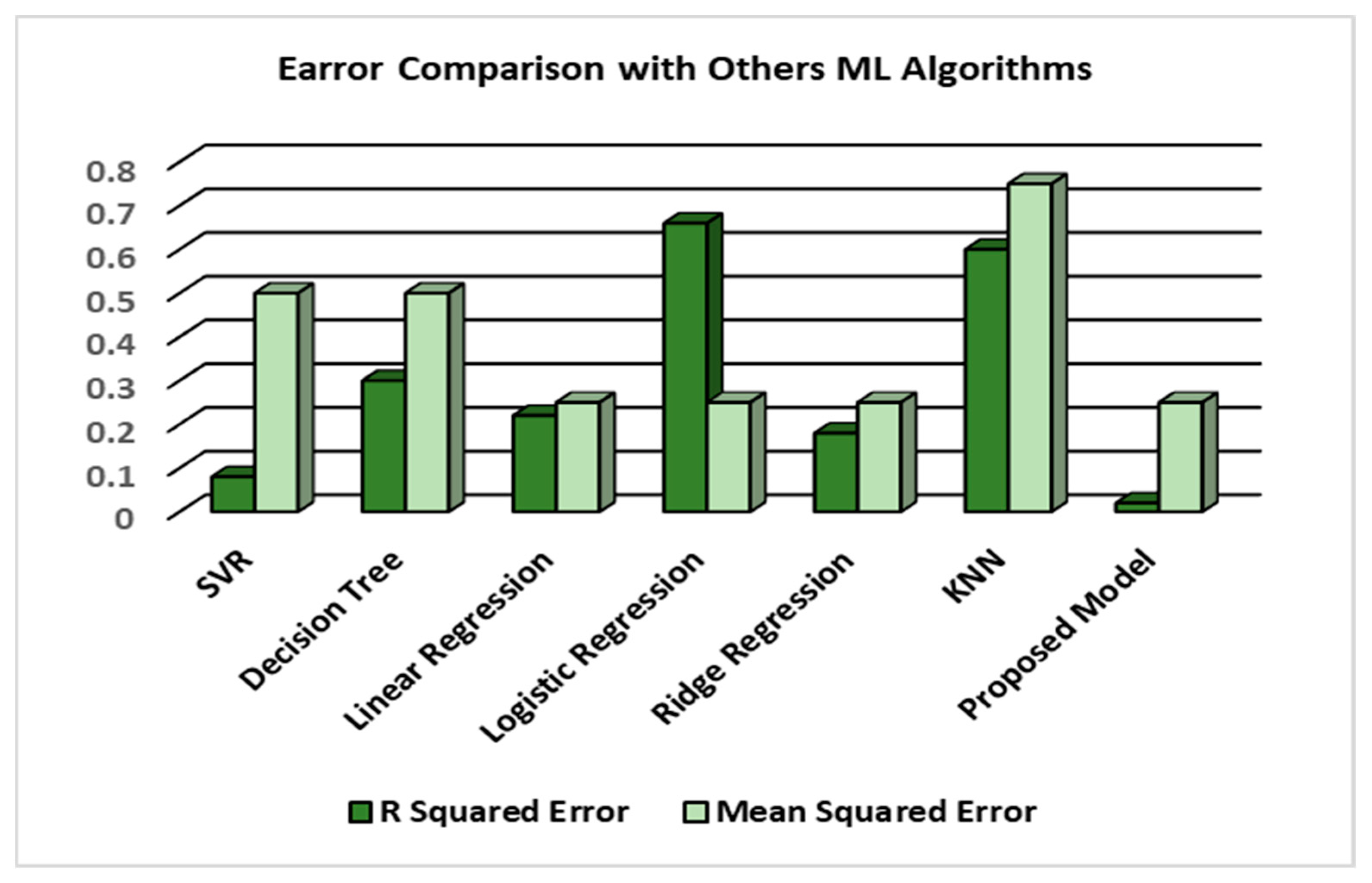
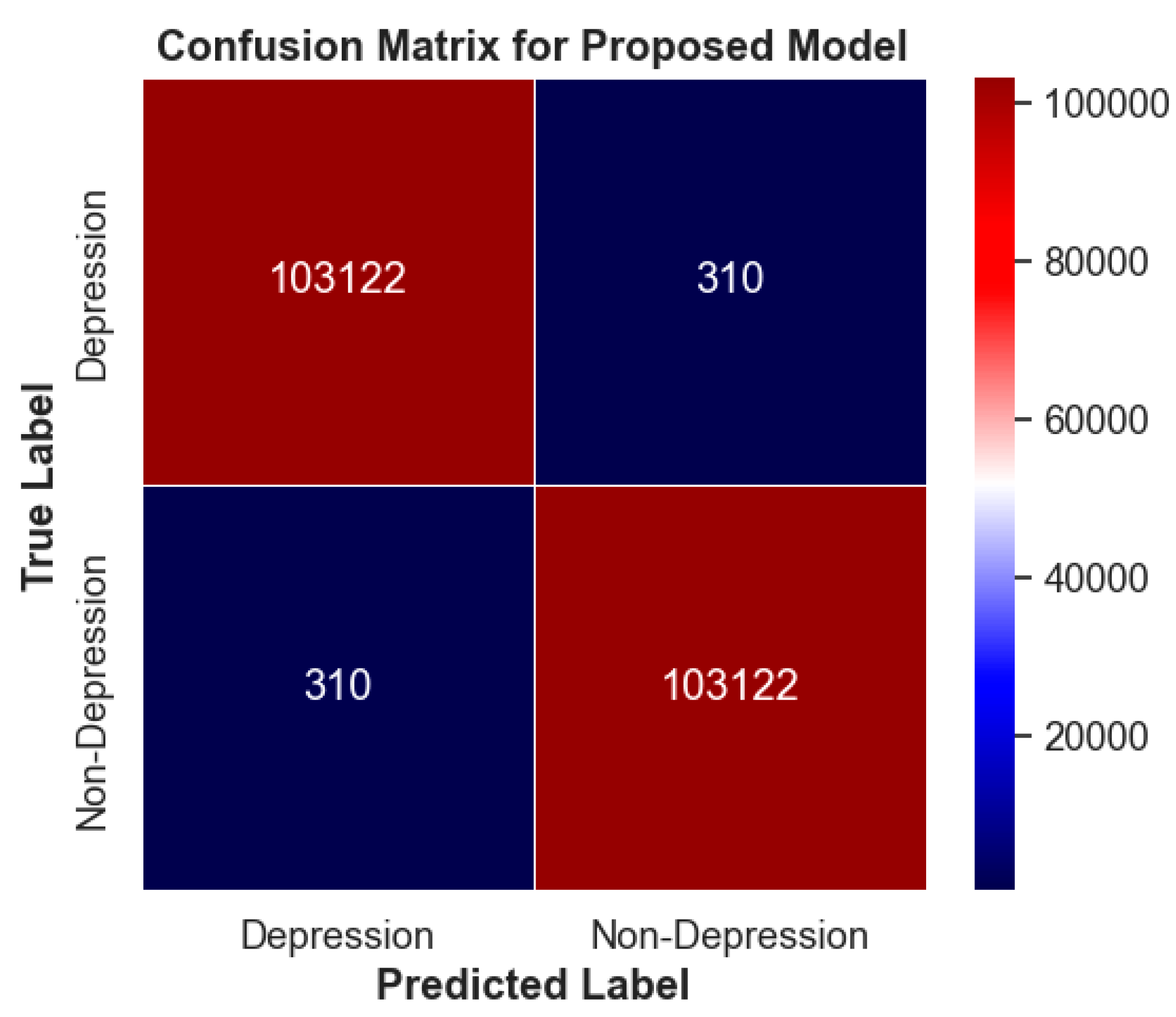
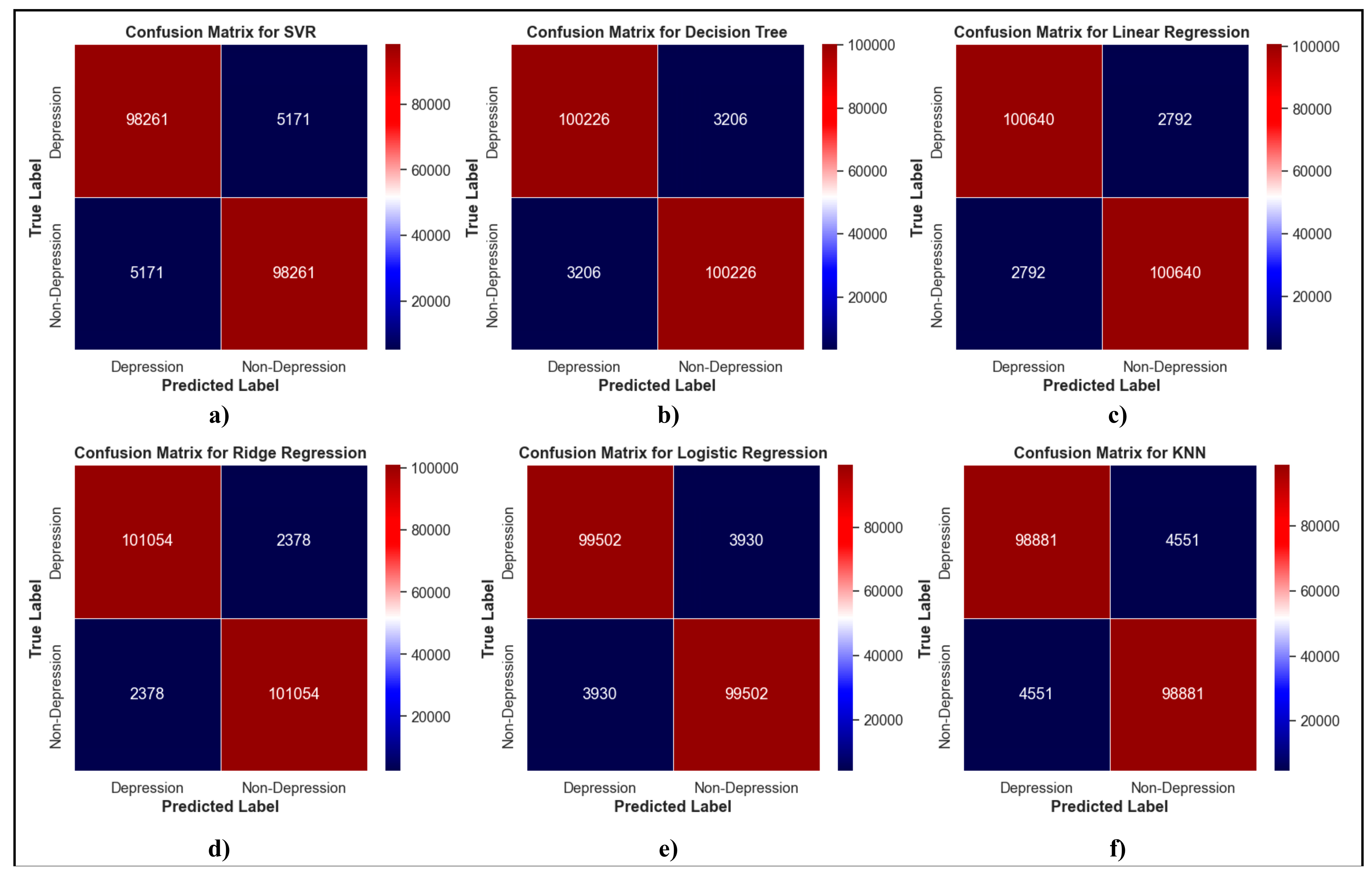
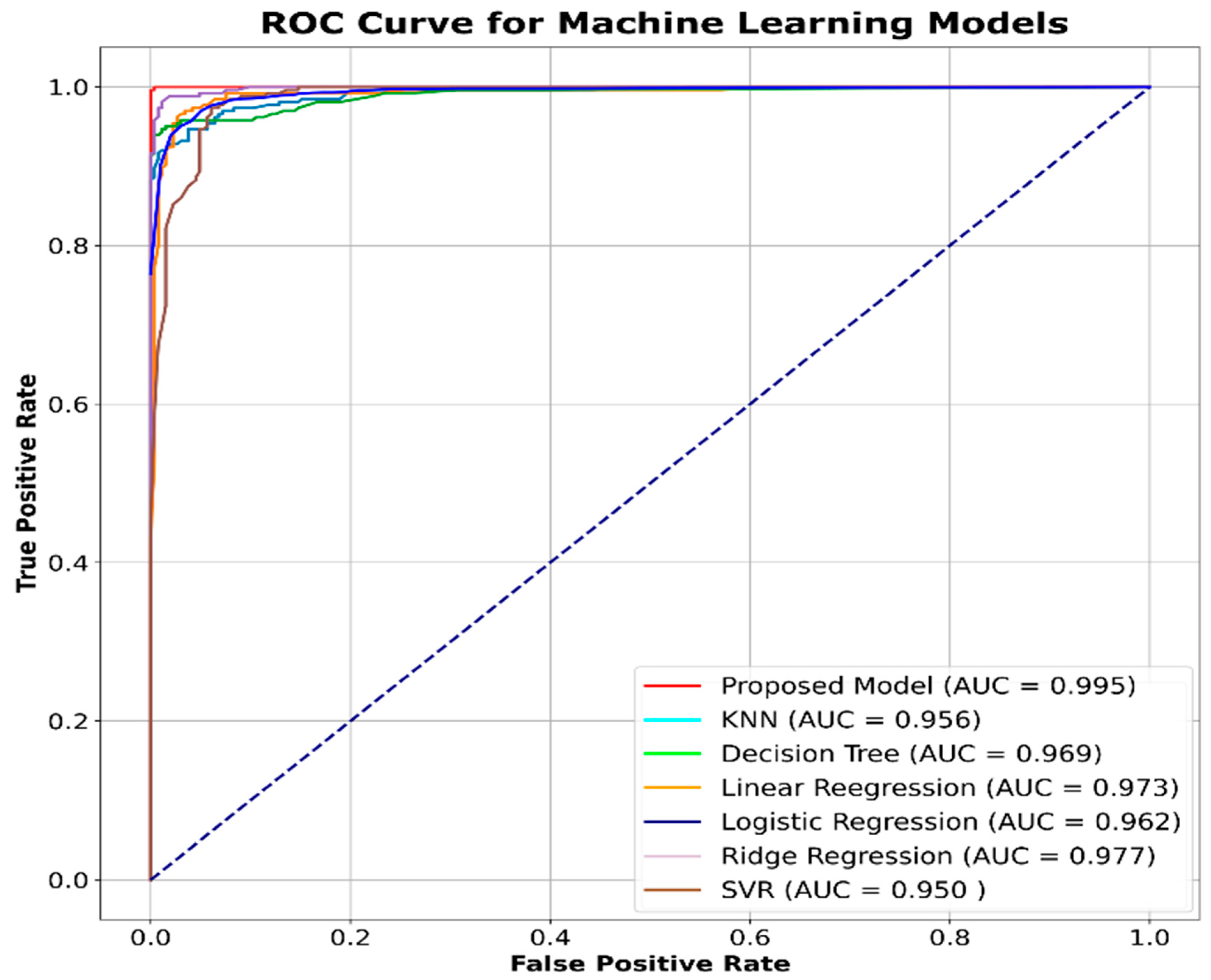
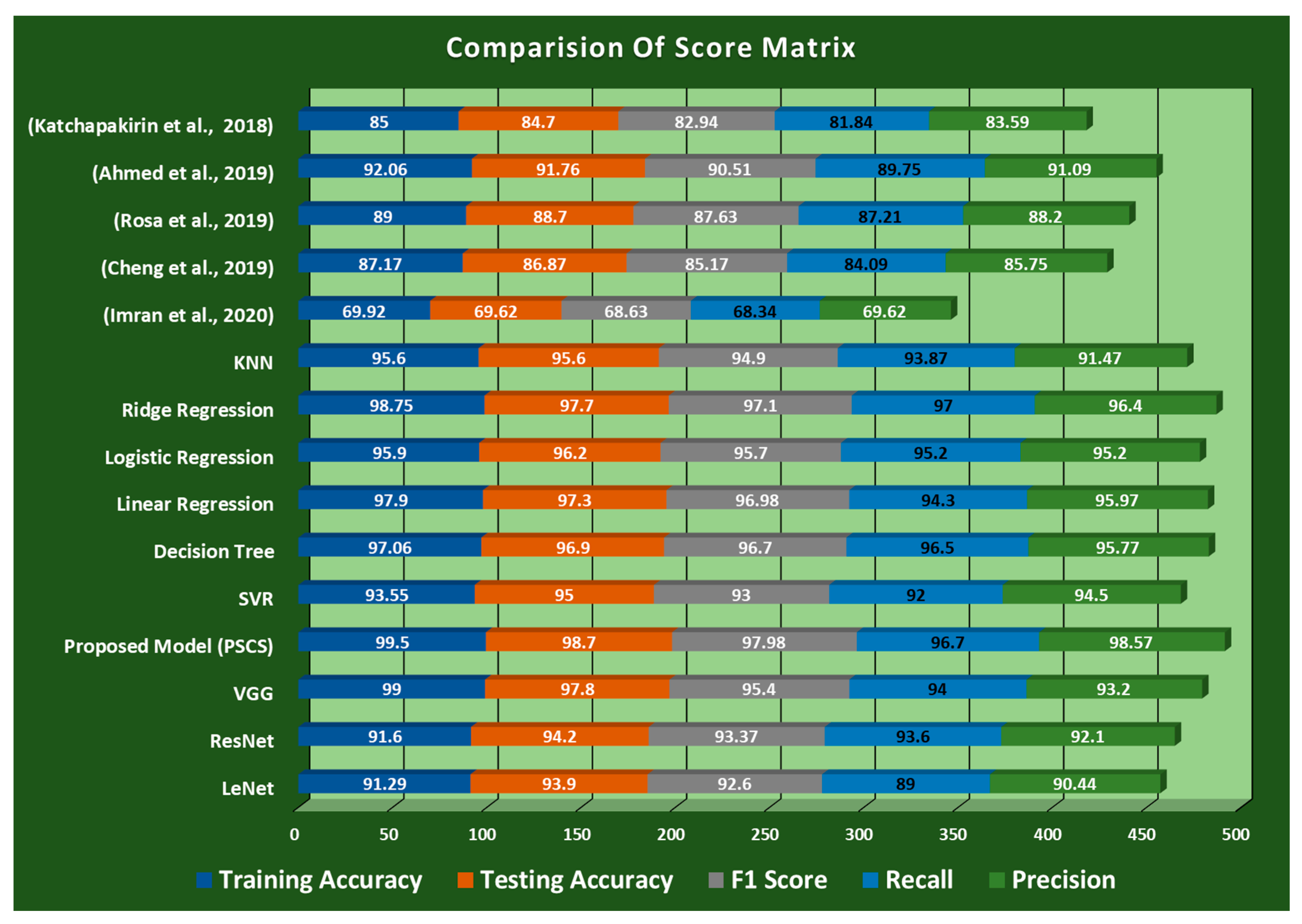
| Specifications | Parameters |
|---|---|
| Processor | Intel(R) Core ™ i9- 12900 k (5.20 GHz) |
| Random Access Memory (RAM) | 64 GB |
| Graphics Processing Unit (GPU) | Nvidia RTX Quadro A5000 |
| IDE | VSCode (Python) |
| Operating System | Ubuntu 20.04.5 LTS (Windows WSL) |
| Layer | Filters/Neurons | Filter Size | Size of Feature Map | Activation Function |
|---|---|---|---|---|
| Input | None | None | None | |
| Convolution 1 | 256 | Relu | ||
| Avg-Pooling 1 | None | None | ||
| Convolution 2 | 128 | Relu | ||
| Avg-Pooling 2 | None | None | ||
| Flatten | None | None | 256 | Flatten |
| Dropout | None | None | 128 | Dense |
| Dense | 2 | None | 64 | Softmax |
| Parameters | Description | PSO | CS | PS-CS |
|---|---|---|---|---|
| w | Inertia weight | 0.65 | - | - |
| C1 | Learning factor | 1.2 | - | 1.2 |
| C2 | Learning factor | 2 | - | 2 |
| N | Population size | 100 | 80 | - |
| M | Iteration | 100 | 300 | 100 |
| Pc | Crossover probability | - | - | - |
| Pm | Variation probability | - | - | - |
| wmax | Maximum inertia weight | - | - | 0.9 |
| wmin | Minimum inertia weight | - | - | 0.3 |
| Nmax | Maximum population size | - | - | 100 |
| Nmin | Minimum population size | - | - | 20 |
| Pa | Abandonment rate | - | 0.25 | 0.25 |
| Pamin | Maximum probability | - | 0.2 | 0.2 |
| Pamax | Minimum probability | - | 0.6 | 0.6 |
| α | Step size | - | 0.03 | 0.03 |
| Type of Algorithm | Training Accuracy | Testing Accuracy | F1 Score | Recall | Precision |
|---|---|---|---|---|---|
| Proposed Model (PSCS) | 99.5 | 98.7 | 97.98 | 96.7 | 98.57 |
| Katchapakirin et al. (LSTM) [55] | 85 | 84.7 | 82.94 | 81.84 | 83.59 |
| Ahmed et al. (LSTM and CNN) [21] | 92.06 | 91.76 | 90.51 | 89.75 | 91.09 |
| Rosa et al. (CNN and BiLSTM) [22] | 89 | 88.7 | 87.63 | 87.21 | 88.2 |
| Cheng et al. (BiLSTM) [23] | 87.17 | 86.87 | 85.17 | 84.09 | 85.75 |
| Imran et al. (LSTM) [7] | 69.92 | 69.62 | 68.63 | 68.34 | 69.62 |
Disclaimer/Publisher’s Note: The statements, opinions and data contained in all publications are solely those of the individual author(s) and contributor(s) and not of MDPI and/or the editor(s). MDPI and/or the editor(s) disclaim responsibility for any injury to people or property resulting from any ideas, methods, instructions or products referred to in the content. |
© 2023 by the authors. Licensee MDPI, Basel, Switzerland. This article is an open access article distributed under the terms and conditions of the Creative Commons Attribution (CC BY) license (https://creativecommons.org/licenses/by/4.0/).
Share and Cite
Jawad, K.; Mahto, R.; Das, A.; Ahmed, S.U.; Aziz, R.M.; Kumar, P. Novel Cuckoo Search-Based Metaheuristic Approach for Deep Learning Prediction of Depression. Appl. Sci. 2023, 13, 5322. https://doi.org/10.3390/app13095322
Jawad K, Mahto R, Das A, Ahmed SU, Aziz RM, Kumar P. Novel Cuckoo Search-Based Metaheuristic Approach for Deep Learning Prediction of Depression. Applied Sciences. 2023; 13(9):5322. https://doi.org/10.3390/app13095322
Chicago/Turabian StyleJawad, Khurram, Rajul Mahto, Aryan Das, Saboor Uddin Ahmed, Rabia Musheer Aziz, and Pavan Kumar. 2023. "Novel Cuckoo Search-Based Metaheuristic Approach for Deep Learning Prediction of Depression" Applied Sciences 13, no. 9: 5322. https://doi.org/10.3390/app13095322
APA StyleJawad, K., Mahto, R., Das, A., Ahmed, S. U., Aziz, R. M., & Kumar, P. (2023). Novel Cuckoo Search-Based Metaheuristic Approach for Deep Learning Prediction of Depression. Applied Sciences, 13(9), 5322. https://doi.org/10.3390/app13095322








